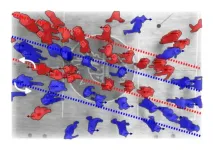(Press-News.org) Have you ever received an unwanted gift and still said ‘thank you’? This choice to hide a negative emotion is a display rule — one of many which define socially appropriate responses to emotions. Although display rules can promote interpersonal harmony, they can also have negative consequences for the person choosing to change how they express emotions. As more social interaction goes online, scientists are investigating how emojis are used to reflect our emotions in different contexts. Are there display rules that apply to emojis, and how do those affect people’s wellbeing?
“As online socializing becomes more prevalent, people have become accustomed to embellishing their expressions and scrutinizing the appropriateness of their communication,” said Moyu Liu of the University of Tokyo, who investigated this question in a study published in Frontiers in Psychology. “However, I realized that this may lead us to lose touch with our authentic emotions.”
Emojis and emotions
Liu recruited 1,289 participants, all users of the most-downloaded emoji keyboard in Japan, Simeji, to investigate how emojis were used to express or mask emotions. Previous research had established that people use emojis as functional equivalents of facial expressions, but not the relationships between emotions expressed and experienced. This is when display rules can prove problematic: if the dissonance between the emotions that you experience and the emotions that you can express is too great, emotional exhaustion can develop, although members of different cultures experience this differently.
Display rules impact more on negative emotions, which it is usually considered less appropriate to express. It is also often more acceptable to express emotions to someone who is closer to you, and it can be more acceptable for a particular gender to express particular emotions. It can also be considered more acceptable to express negative emotions in more individualist societies.
Wearing your heart on your screen
The participants in Liu’s study provided demographic data, answered questions about their subjective wellbeing, and rated how often they use emojis. They were given messages with varying social contexts, responded to them as they would normally, and rated the intensity of the expression of their emotions.
Liu found that people chose to express more emotions with emojis in private contexts or with close friends. Respondents expressed least emotion towards higher-status individuals. Intense expressions of emotion came with matching emojis, unless people felt the need to mask their true emotions: for instance, using smiling emojis to mask negative emotions. Negative emojis were used only where negative feelings were very strongly felt. Expressing emotions with emojis was associated with higher subjective wellbeing compared to masking emotions.
“With online socializing becoming ever more prevalent, it is important to consider whether it is causing us to become more detached from our true emotions,” said Liu. “Do people require a ‘shelter’ to express their genuine emotions, and is it possible to break free from pretense and share our true selves in online settings?”
Liu emphasized that the study should be expanded in the future. The Simeji keyboard is extremely popular among young women, which skewed the sample towards women and generation Z. However, this also reflected the gender imbalance in use of emojis in general and the Simeji keyboard in particular. A broader pool of participants would provide a fuller picture of the display rules around emojis.
“First, the highly gender-imbalanced sample may have led to stronger results. Future research should explore potential gender differences in emoji display rules and examine the structural issues surrounding the formation of these emotion cultures,” cautioned Liu. “Second, Japanese culture's emphasis on interpersonal harmony and concealment of negative emotions may have influenced the results.”
“I would welcome the opportunity to expand this study and investigate the display rules for emojis across different genders and cultures,” added Liu. “Collaboration with scholars from diverse cultural backgrounds would be invaluable in this endeavor, and I am open to any contact.”
END
Scientists find that people use emojis to hide, as well as show, their feelings
Scientists studying emoji use in Japan found that the images were used to soften the impact of negative expressions as well as to express positive feelings
2023-03-03
ELSE PRESS RELEASES FROM THIS DATE:
AI used to predict future flares of ulcerative colitis activity
2023-03-03
Ulcerative colitis assessment could be improved after new research shows that an artificial intelligence model could predict flare-ups and complications after reading biopsies.
In a new paper published in Gastroenterology today (Friday 3 March), researchers supported by the National Institute for Health and Care Research Birmingham Biomedical Research Centre have trialled an AI diagnostic tool that can read digitised biopsies taken during colonoscopy.
The Computer-Aided Diagnostic model was able to predict the risk of flare-ups for ulcerative colitis, which is a relapsing-remitting ...
Uncovering the voice of toothed whales: A distinct nasal structure helps produce diverse sounds
2023-03-02
Toothed whales like dolphins, orcas, and sperm whales produce their diverse repertoire of sounds through a distinct structure in the nasal passages, but in a way that is strikingly similar to the way terrestrial animals use the larynx or syrinx for vocalization. In a new study, researchers who employed four different techniques to get to the bottom of how these animals make the sounds they do describe this novel sound production system and show how it enables toothed whales to use different vocal registers for echolocation and communication. To date, vocal registers have been confirmed only in humans and crows. Odontocetes (toothed whales) navigate and hunt ...
Study reveals record-high carbon dioxide emissions from boreal fires in 2021
2023-03-02
Boreal fires, which typically account for 10% of global fire carbon dioxide emissions, contributed 23% in 2021, a new study reports. “Boreal forests could be a time bomb of carbon, and the recent increases in wildfire emissions we see make me worry the clock is ticking,” said study author Steven Davis, who will participate in an embargoed briefing on this study this week. Extreme wildfires – which impact the climate through the carbon dioxide they emit – have become more common. Wildfires in tropical forests ...
Largest-ever genetic analysis of grapevine varieties reveals how glacial cycles shaped grape domestication and the rise of wine
2023-03-02
In the largest ever genetic analysis of grapevine varieties, including samples from previously undocumented specimens in private collections, researchers provide new insights into how, when, and where wine and table grapevines were domesticated, which has been a longstanding question. “This work represents a major international collaborative effort, challenging to do in any circumstances but especially so given that we conducted it during the COVID-19 pandemic and associated lockdowns,” said author Wei Chen, who will also participate in an embargoed briefing ...
Ecological improvement of freshwater ecosystems benefits fish and people
2023-03-02
Biodiversity is declining rapidly. Many conservation actions focus on single species. An alternative approach is to comprehensively improve ecological processes and habitats, thereby supporting entire species communities. This so-called ecosystem-based management is however rarely implemented because it is costly. There is also a lack of evidence that ecosystem-based habitat management is more effective than obvious alternatives, such as releasing animals to enhance stocks.
Important lesson for fish conservation
A research team based in Berlin, in close cooperation with numerous angling clubs organized in ...
Most detailed geological model reveals Earth’s past 100 million years
2023-03-02
Climate, tectonics and time combine to create powerful forces that craft the face of our planet. Add the gradual sculpting of the Earth’s surface by rivers and what to us seems solid as rock is constantly changing.
However, our understanding of this dynamic process has at best been patchy.
Scientists today have published new research revealing a detailed and dynamic model of the Earth’s surface over the past 100 million years.
Working with scientists in France, University of Sydney geoscientists have published this new model in the prestigious journal Science.
For the first time, it ...
Animals best to supress personalities for group efficiency
2023-03-02
Social animals should limit individuality to conform with the behaviour of the group, a University of Bristol study has found.
Scientists at Bristol’s School of Biological Sciences observed that group safety was improved when animals paid attention to the behaviours of each other.
Their findings, published today in PLoS Computational Biology, reveal that simple social behavioural rules can drive conformity behaviour in groups, eroding consistent behavioural differences shown by individual animals.
Lead author Dr Sean Rands said: “Personality suppression may ...
Possible treatment strategy identified for bone marrow failure syndrome
2023-03-02
Bone marrow is the spongy tissue inside bone responsible for making red blood cells, white blood cells and platelets. Bone marrow failure syndromes lead to an increased risk of developing dangerous infections, anemia and an increased risk of blood cancers.
Research led by Washington University School of Medicine in St. Louis has identified a possible treatment strategy for a rare bone marrow failure syndrome that is named poikiloderma with neutropenia. The work also may have implications for treating other bone marrow failure syndromes with similar underlying dysfunctions.
The research is published March 3 in the journal ...
Stick to your lane: Hidden order in chaotic crowds
2023-03-02
Have you ever wondered how pedestrians ‘know’ to fall into lanes when they are moving through a crowd, without the matter being discussed or even given conscious thought?
A new theory developed by mathematicians at the University of Bath in the UK led by Professor Tim Rogers explains this phenomenon, and is able to predict when lanes will be curved as well as straight. The theory can even describe the tilt of a wonky lane when people are in the habit of passing on one side rather than the other (for instance, in a situation where they are often reminded to ‘pass on the right’).
This mathematical ...
Crowdsourced reports can quickly identify an earthquake’s impact
2023-03-02
Within minutes, a statistical model based on a global database of public reports of ground shaking can be used to identify an earthquake as a high- or low-impact event, according to a new study published in The Seismic Record.
High-impact earthquakes, as defined by the study, are those associated with at least one destroyed building, at least 50 damaged buildings, at least two deaths, or any documented financial losses.
The researchers were able to provide impact results for 393 global earthquake events from 2021 within 10 minutes. Their model was developed using more than 1.5 million globally collected felt ...
LAST 30 PRESS RELEASES:
Heart-brain connection: international study reveals the role of the vagus nerve in keeping the heart young
Researchers identify Rb1 as a predictive biomarker for a new therapeutic strategy in some breast cancers
Survey reveals ethical gaps slowing AI adoption in pediatric surgery
Stimulant ADHD medications work differently than thought
AI overestimates how smart people are, according to HSE economists
HSE researchers create genome-wide map of quadruplexes
Scientists boost cell "powerhouses" to burn more calories
Automatic label checking: The missing step in making reliable medical AI
Low daily alcohol intake linked to 50% heightened mouth cancer risk in India
American Meteorological Society announces Rick Spinrad as 2026 President-Elect
Biomass-based carbon capture spotlighted in newly released global climate webinar recording
Illuminating invisible nano pollutants: advanced bioimaging tracks the full journey of emerging nanoscale contaminants in living systems
How does age affect recovery from spinal cord injury?
Novel AI tool offers prognosis for patients with head and neck cancer
Fathers’ microplastic exposure tied to their children’s metabolic problems
Research validates laboratory model for studying high-grade serous ovarian cancer
SIR 2026 delivers transformative breakthroughs in minimally invasive medicine to improve patient care
Stem Cell Reports most downloaded papers of 2025 highlight the breadth and impact of stem cell research
Oxford-led study estimates NHS spends around 3% of its primary and secondary care budget on the health impacts of heat and cold in England
A researcher’s long quest leads to a smart composite breakthrough
Urban wild bees act as “microbial sensors” of city health.
New study finds where you live affects recovery after a hip fracture
Forecasting the impact of fully automated vehicle adoption on US road traffic injuries
Alcohol-related hospitalizations from 2016 to 2022
Semaglutide and hospitalizations in patients with obesity and established cardiovascular disease
Researchers ‘listen in’ to embryo-mother interactions during implantation using a culture system replicating the womb lining
How changing your diet could help save the world
How to make AI truly scalable and reliable for real-time traffic assignment?
Beyond fragmented markets: A new framework for efficient and stable ride-pooling
Can shape priors make road perception more reliable for autonomous driving?
[Press-News.org] Scientists find that people use emojis to hide, as well as show, their feelingsScientists studying emoji use in Japan found that the images were used to soften the impact of negative expressions as well as to express positive feelings



